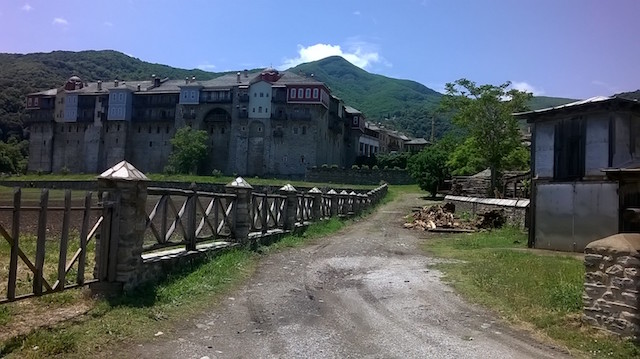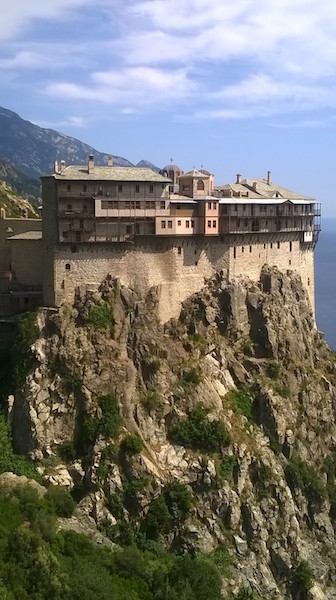
When we travel we often yearn for the end of the road, the border between modern life and a time untouched by progress. My son Adrian and I had the opportunity to return to the past when we arrived in May at Mount Athos, a semi-autonomous, monastic peninsula in northern Greece.
Monks began to set up monasteries there in medieval times, having established the first, the Great Lavra, in 963. Today there are 20 monasteries.
I always wanted to come to Athos for its undeveloped beauty, its Byzantine art and architecture, and the overall monastic experience. After obtaining a permit, I contacted three monasteries to stay overnight. Mount Athos is open only to men, who are entitled to stay three nights.
On the ferry from Ouranoupolis (the city of heaven) I could see that most of the passengers were Greek, though 40% were Russian. (Rasputin was a famous Russian pilgrim and President Putin was scheduled to come on May 28 to celebrate the 1000th anniversary of the Russian monastery of Panteleimon.)
During our four days on Athos we met men from Syria, Lebanon, Romania, Bulgaria, Georgia, Serbia, Germany, and Poland. Some were frequent visitors. Reinhardt, a German in his late sixties, was baptized on Mount Athos as Gregory and has been coming twice a year for 30 years. Imad from Lebanon brought a group of men each May and October.
There are monasteries along the coast and within the interior. In the past people walked from one to another, though there are now roads where you can see buses and taxis driven by monks with long beards and black vestments.
The bus having left us on the cross of the road, we trekked down a forested path to the Monastery of Stavronikita, dating from the 10th century. Past the trees we made out a whimsical structure with a tower, domes, and high walls, vegetable gardens, pools with water lilies, lemon groves, and olive orchards, all next to the sea. We lingered under a trellis of wisteria, wondering if this was all real.

Later in the reception room we introduced ourselves to a young monk who showed us to our room overlooking the central courtyard. From my bed, I could see the domes of the chapel, the slate roof of other structures—all sorts of curvilinear patterns.
Evening service was at six followed by dinner at 7:30 served in the refectory, which, because Stavronikita has no electricity, was lit only by candles. As we processed into the hall, we saw two long rows of tables with benches on each side. On the tables the monks had arranged for each guest a pewter bowl with potato stew, a plate of a salad, sliced bread, a boiled egg and an apple.
Almost everything eaten in Athos is grown on the grounds or foraged in the surrounding hills. Monks don’t consume meat and on fasting days (Wednesdays and Fridays, Lent, and before some other feast days) they follow a vegan diet and have only one meal.
As soon as we began our meal, a monk began to read a sermon. Adrian and I looked at each other nervously. No talking was permitted. After twenty minutes the monks rose, collectively pushed the bench below the table and marched out and we were instructed to follow suit.
After dinner we explored the grounds and returned to the reception room where another monk served coffee. I had so many questions. When did he come here? “I was born in Stavronikita,” he answered. I was struck by this. To say you are born in Stavronikita means you renounce your previous life, your family, and education. He did not want to talk about his previous life. Did he ever leave Athos? “No,” was his response. “Why would I ever leave?” And I, as a father of two sons, felt the tightening of my stomach at the thought of losing them to monasticism. I could not get myself to ask him why he chose the monastic life but promised to see him at the matins service, which started at 3:00 am and lasted four hours.
Although I heard the bells ringing, my jet-lag and lack of sleep for days kept me from my promise. As no breakfast was served, we made our way along the sea-path to Iviron, the biggest monastery we visited.
Built by Georgian monks in 980, it seemed like something out of Shangri-la, a castle-like structure with living quarters perched high on walls, painted in red, white, and ochre, and laced with balconies. Unlike Stavronikita, which could only accommodate about 20 pilgrims, this one could take close to 100.

I wanted to go to the service in the morning. So hearing the bells, I got dressed and strode through the dark courtyard illuminated by the full moon. I made out the shadows of black vestments moving toward the church. To my right I picked up the sweetness of the jasmine bush.
As much as I tried, however, I could not stand for the whole service. The hiking from the previous day made my thighs and lower back ache. I had to take a break so I stepped out to stroll a bit in the courtyard. With the big, metal gates shut, I walked rounds of the church, hearing the chanting, and trying to locate the various trees by their scents. I returned and stayed to the end after which we had breakfast: slices of bread, sage tea, and olives.
By ten we took a bus to our original port of entry and then hiked to Simonos Petra (thirteenth century). I had eagerly anticipated our visit here. For three days pilgrims expressed surprise that we had gotten rooms there for it had the reputation of being a most difficult place to get into. And I could see why. Simonos Petra is pure sublimity, a synthesis of nature, human architecture, light and sea, a place where thought turns to air.

You have to imagine a ravine between two mountains and a huge rock in front, out of which rises Simonos Petra, like earth’s present to the heavens. And when you sit in the terrace of the guest house, you look at the cliff before you, covered with trees and wild flowers, and hear the water fall. In front is the monastery and beyond the sea. Standing next to me on the balcony, a Polish archaeology student told me, “you have to ask who could have created such an ethereal place if not God.”
I wanted to talk with the monks but I realized that on the whole they only exchanged greetings with us. For various reasons, they kept to their tasks and study. It is their right. We were the ones who descended on their life. They provided hospitality, washed our dishes, cleaned the toilets, and asked nothing in return. They have also collectively guarded some of the greatest cultural treasures in the world. And they have preserved for posterity a whole peninsula from the ravages of development. Thanks to them Trip Advisor will never create a list of the top Athos monasteries to visit. And none of the refectories will be turned into luxury boutique hotels. Mount Athos has essentially been a protected park for over 1000 years, a Yosemite ahead of its time.
This is a major reason men visit the place. Over and over again they told me they longed for peace and serenity—to be delivered from cares and anxieties of life. Indeed, when in Stavronikita I asked a monk what he thought pilgrims would gain on Athos, his answer was quick: tranquility. And I who toiled though worries, fears, preoccupations, longed for heavenly calm.
But in the course of my four days I came to discover how unreachable this goal was. My feeling of transcendence was tempered by one of claustrophobia. I feared that the boat to Ouranopolis would leave me stranded in paradise, away from my family, my work, and my communication with the world.
The monks have achieved serenity by submission to a prescribed rhythm. For a millennium they have prayed and followed the same rituals, displaying the conviction of people who had spoken with the Absolute. Their granite certainty contrasted with the shakiness of my faith, which in comparison seemed like a jigsaw puzzle of doubt.
This was made apparent again in our final supper. The walls and ceiling of the refectory at Simonos Petra were covered in Byzantine frescoes, resplendent in the afternoon light. As I sat, enjoying what was the best meal on Athos, I prayed for the sermon to last an hour so that I could savor the wild bitterness of the greens the monks had foraged, the olive oil they had pressed, the garlic and lemon sauce on the potatoes. I wished to behold the divine and mystical images, to chat with my neighbors about what they were feeling. But this was not possible. In 20 minutes the sermon ended and we were instructed to march out.
I wanted aesthetic pleasure for its own sake, yearning for joy here and now, fraternity with my fellow pilgrims. But for the monks what was important was the preparation for the next life.
I was determined, however, to make it through the entire service the next morning. I got up, climbed up the steps to the church and leaned against the wall of the vestibule. A monk, much older than me, stood the entire time. I tried tensing and relaxing my thighs and calves, curling my toes into my shoes, leaning to the side of each foot. And I let myself be transported by the chanting, the most airy and uplifting I have ever heard. Behind me the light began to enter from the window, illuminating the church.
At the end of the service, after the monks left with their stern but beatific expressions, I stepped out to the terrace, hundreds of feet from the sea. At the distance the sun shimmered, calming the waves of the Aegean. The morning was all aglow. Was I beholding a revelation?



